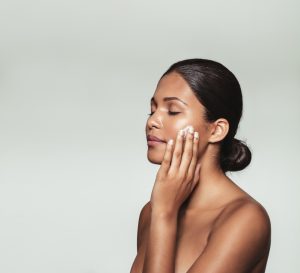As summer transitions to fall, there’s another transition you should be aware of – your skin health. A change in seasons can make your skin do crazy things, especially the hot-to-cold transition that occurs during this time. Read on for all of the best fall skin care tips that’ll help you transition smoothly from sweaty weather to sweater weather.
How The Summer-Fall Transition Affects Skin
Weather Changes
As summer turns to fall, temperature and humidity drop quickly in many regions. As cold weather and windy skies take over the forecast, your skin has to work hard to maintain adequate hydration. This loss of moisture in your skin cells can lead to:
- Damage in the outer skin layer
- Loss of hydration
- Skin irritation1
The change of weather can also impact your skin’s oil glands. So with fall temperatures, breakouts may either get better or worse, depending on your situation.2
Lifestyle Changes
Beyond the change in weather, the new season can bring about lifestyle changes that affect all skin types, especially sensitive skin.
 In cooler temperatures, you may be more likely to indulge in long, hot showers and crank up central heat indoors. Both of these habits can lead to excessively dry skin.3,4
In cooler temperatures, you may be more likely to indulge in long, hot showers and crank up central heat indoors. Both of these habits can lead to excessively dry skin.3,4
These activities don’t only dry out the skin, they can also damage the surface of the skin. Extremely dry skin can lead to:
- Scaliness
- Redness
- Itchy skin5
If you know that your skin can act out during a change in seasons, it’s smart to plan ahead and make a new skincare routine for fall.
Tips For Transitioning From Summer To Fall
Book A Facial
If you can swing it, some experts recommend booking a professional facial at the start of the season.6Facials can help slough off skin damage from the summer months. They can treat pores clogged with months of layered-on sunscreen or dark spots caused by a fading tan. Controlled exfoliation can also help break down your outermost skin cells so you start the new season with a glow.7
Booking a facial also gives you the opportunity to talk with a skincare expert or dermatologist about your skin. A professional can assess your personal complexion – for example, do you have clogged pores, dull skin, or brown spots? From there, you can develop a personal skincare routine that will set you up for success in the new season.
Find A Moisturizing Cleanser
To help your skin deal with the weather change, seek out a balancing cleansing lotion or a cream cleanser. Avoid using soaps or foaming cleansers that strip away your skin’s natural oils.
Look for these ingredients in a facial cleanser:
- Hyaluronic acid – This moisture molecule helps skin lock in moisture.
- Vitamin E – A natural antioxidant that nourishes the skin and helps to fight free-radicals.
- Fruit enzymes – Gentle enzymes that help exfoliate the skin.
Use your new moisturizing cleanser in a lukewarm (not too hot) shower, or rinse to make sure you keep your skin hydrated.8
Switch To A Heavier Moisturizer
 The climate loses humidity as we move into fall. You’ll want to seek out a hydrating moisturizer to compensate.
The climate loses humidity as we move into fall. You’ll want to seek out a hydrating moisturizer to compensate.
If you have an oily skin type and you’re hesitant to use moisturizer, you may need it more than ever. When your skin becomes dry, it produces more oil, which can lead to breakouts or an oily sheen on the face.
No matter your skin type, it’s a good idea to deeply hydrate during the cooler months.
Look for a moisturizer that is specially formulated with hydrating ingredients like hyaluronic acid (sodium hyaluronate) and aloe vera.
Keep Using Sun Protection
Just because temps are cooler, it doesn’t mean you should lay off the sunscreen. UVB rays (the ones that cause sunburns) weaken in the fall, but UVA rays (the ones that cause fine lines and wrinkles) are just as strong. Both types of UV rays can cause skin damage.
Wear protective clothing (such as wide-brimmed hats), and look for a sunscreen with these traits:
- SPF 30 or above
- A hydrating formula that contains ingredients like glycerin or aloe vera
- If you tend to forget to apply sunscreen, look for face makeup in your skin tone that contains SPF
Use Lip Moisturizer, Eye Creams, And Specialized Products
If you coasted through summer just using a light moisturizer, it’s time to call in for reinforcements. Consider adding eye cream and a special moisturizer for your lips to your routine. Your skin could likely use the added moisture. To up your game even more, try out a deeply hydrating nighttime serum or face mask.
Change Your Exfoliating Routine
If your skin is looking flaky, you may be tempted to exfoliate more. But skincare experts say that you should actually exfoliate less in the colder months. Over-exfoliation can weaken skin.12Chemically exfoliating ingredients, like glycolic acid, should still be used, but should be used less frequently in the fall. If you’re unsure, ask your dermatologist.
Start Using A Body Lotion
While you’re doubling down on moisturizers, don’t forget the rest of your body. Applying a moisturizer from head to toe can help combat seasonal dryness. Experts recommend applying body cream within 5 minutes of stepping out of the shower. This helps you lock in your skin’s natural moisture.13
Invest In A Humidifier
As the weather gets colder, many people start to pump indoor heat. Artificial heat makes indoor air extremely dry. The cold weather outdoors can make the air out there dry too. And all of that dry air makes your skin dry. What’s a person to do? You may want to pick up a humidifier.
Hey, summer humidity is (finally) over. Isn’t it time to artificially make it humid again?
A humidifier can add moisture back into the air, which in turn helps keep your skin hydrated.
Humidifiers are not only moisturizing for your skin – they can positively impact your body’s overall hydration.14
Embrace The New Season
 Many people love fall for the change in weather and the new coziness in the air. While you’re sipping your pumpkin spice latte, wrapping yourself in soft sweaters, and getting into the hygge spirit, remember to also extend this care to your skin.
Many people love fall for the change in weather and the new coziness in the air. While you’re sipping your pumpkin spice latte, wrapping yourself in soft sweaters, and getting into the hygge spirit, remember to also extend this care to your skin.
Fall is a great time to slow down, take your time, and practice self-care. Massage specialty products into your skin, layer on nourishing moisturizers, and use nourishing face masks. Treat yourself. You’ll feel better, and your skin will too.
Learn More:
Are Vitamins Good For Skin Care? Do They Really Work?
How Often Should You Use a Face Mask?
Exfoliation Secrets: AHA vs BHA — What’s the Difference?
Sources
1. https://www.allure.com/story/how-seasons-weather-affect-skin
2. https://www.instyle.com/beauty/fall-skincare-tips-2018
3. https://www.bcm.edu/news/skin-and-hair/hot-showers-can-damage-skin-winter
4. https://www.refinery29.com/en-us/central-heat-skin-effects
5. https://www.health.harvard.edu/diseases-and-conditions/is-that-dry-skin-really-something-more-serious
6. https://www.byrdie.com/fall-beauty-treatments
7. https://www.vogue.com/article/fall-skincare-tips
8. https://www.shape.com/lifestyle/beauty-style/skin-care-tips-cool-fall-weather
9. https://www.aad.org/public/diseases/acne-and-rosacea/moisturizer
10. https://www.self.com/story/what-you-should-know-about-face-oils
11. https://www.cosmopolitan.com/style-beauty/beauty/a61863/best-sunscreen-for-fall/
12. https://www.totalbeauty.com/content/slideshows/fall-skin-care-tips-181003/page10
13. https://www.self.com/story/the-best-time-to-moisturize
14. https://www.allure.com/story/humidifier-skin-benefits

























































